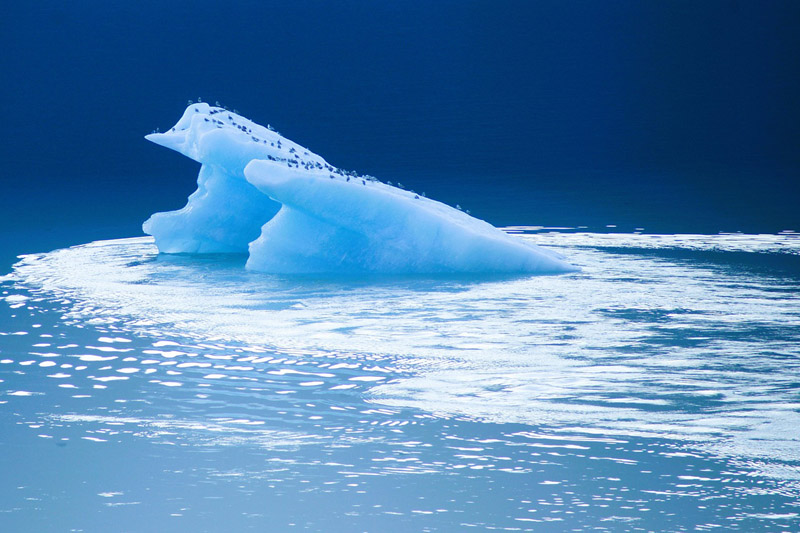 Antarctica
Antarctica Antarctic Bottom Water is the coldest, densest water mass on the planet and plays a pivotal role in regulating the ocean’s ability to store heat and capture carbon.
In a new study, published today in the journal Nature Climate Change, researchers from the British Antarctic Survey (BAS) present how these crucial waters are warming and shrinking in the Weddell Sea in Antarctica, one of the biggest producers of dense bottom water.
This discovery is the first observational evidence that long-term changes to the winds and sea ice are influencing bottom water production in the Weddell Sea.
The observed decline in bottom water could have a huge impact on the world’s oceans leading to less heat and carbon being captured from the atmosphere and trapped in the deep ocean.
The ocean has absorbed over 90% of human induced global heating and almost a third of the extra carbon released since the start of the industrial revolution.
Using decades of ship-based observations alongside satellite data, the team discovered that these waters have been declining in volume over the past 30 years.
The measurements are a result of many scientific voyages to the Weddell Sea, measuring the temperature and saltiness of the oceans from the surface to the seabed.
By revisiting these sections across three decades, the team concludes that the volume of these bottom waters shrunk by more than 20%, while rest of deep waters deeper than 2000 m has been warmed at a rate four times higher than the rest of the global ocean.
Dr Povl Abrahamsen, a physical oceanographer at BAS and co-author, says: “As part of our long-term monitoring, we try to investigate these sections every one or two years. Annual or biennial measurements are needed to disentangle short-term changes from the long-term warming trends, and therefore better understand the causes of both. Some of these sections were first visited as far back as 1989, making them some of the most comprehensively sampled regions in the Weddell Sea”.
Antarctic Bottom Water is a blend of warmer waters, dragged into the Weddell Sea from the Antarctic Circumpolar Current which flows clockwise (as seen from the South Pole) from west to east around Antarctica, and very cold, salty water created when these more northern waters are exposed to the freezing air at the surface around the continent.
The new study discovered that the shrinking bottom waters are a result of changes to rates of sea ice formation, which form a critical stage in producing bottom water.
Weakening winds near the Filchner-Ronne ice shelf in the Southern Weddell Sea have slowed the production rate of sea ice.
Normally, winds act to push the new ice away from the shelf, leaving areas of open water for yet more ice to form.
This weakening is reducing the size of these gaps in the sea ice cover, causing a slowdown in new ice formation.
The creation of new ice is a key process to create the cold, salty waters for Antarctic Bottom Water as new, relatively fresh, sea ice leaves behind salt in the ocean as a result of the freezing process.
Dwindling supplies of these salty shelf waters have led to shrinking bottom waters observed by the team.
Digging further into the wind-driven changes, the team uncovered links with large-scale weather patterns connecting responses in the tropical Pacific to the Southern Ocean. Changes in these large-scale patterns have caused the winds across the Southern
Ocean to fluctuate and shift, reducing the northward winds across the Weddell Sea that cause strong sea ice freezing.
The current changes observed are a consequence of natural variability in the system, although there are potentially stronger changes predicted in the future.
They also align with other recent high profile studies this year that show similar reductions in bottom water coming from the Ross Sea, as well as modelled future collapse in bottom waters; both due to the accelerated melting of Antarctic ice shelves.
Dr Shenjie Zhou, lead author of the study and physical oceanographer at BAS, says:“These results show just how sensitive this region is, specifically the Antarctic abyssal overturning circulation which is a key regulator of global climate, is to the climate changes happening both remotely and locally.
It highlights the complex interplay between atmosphere and sea ice which needs to be properly represented in climate models in order for us to confidently predict how it may respond in the future”.
Dr Alessandro Silvano from the University of Southampton, who is a co-author of the study, says:“The shrinking of deep waters in Antarctica can have far reaching consequences, from reducing the ability of the ocean to absorb carbon associated with human activities to decreasing the oxygen supply to abyssal waters, affecting deep ecosystems. We used to think that changes in the deep ocean could only occur over centuries. But these key observations from the Weddell Sea show that changes in the dark abyss can take place over just a few decades.”
Support Our Journalism
We cannot do without you.. your contribution supports unbiased journalism
IBNS is not driven by any ism- not wokeism, not racism, not skewed secularism, not hyper right-wing or left liberal ideals, nor by any hardline religious beliefs or hyper nationalism. We want to serve you good old objective news, as they are. We do not judge or preach. We let people decide for themselves. We only try to present factual and well-sourced news.







